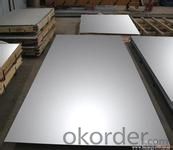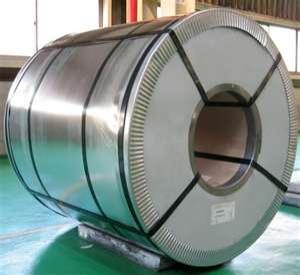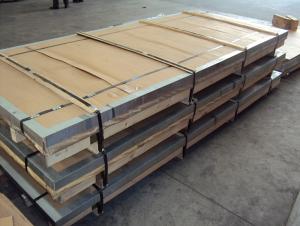Stainless Steel Sheet Hairline Surface Treatment 0.9mmx1220mmx2440mm
- Loading Port:
- Shanghai
- Payment Terms:
- TT OR LC
- Min Order Qty:
- 25 m.t.
- Supply Capability:
- 2500 m.t./month
OKorder Service Pledge
OKorder Financial Service
You Might Also Like
Product Introduction of Stainless Steel Sheet Hairline Surface Treatment 0.9mmx1220mmx2440mm:
Our Stainless Steel products including the stainless steel sheet/plate, stainless steel coil, stainless steel rod/bar, stainless steel angle, stainless steel strip, stainless steel flat, carbon steel products and alloy steel materials. It also can supply the processing of surface, like No.4, BA, HL, SB, 8K, and so on.
Loading Quantity of Stainless Steel Sheet Hairline Surface Treatment 0.9mmx1220mmx2440mm: 25 Tons/20FCL.
Grade of Stainless Steel Sheet Hairline Surface Treatment 0.9mmx1220mmx2440mm: 201, 306, 316 Etc.
Delivery Time of Stainless Steel Sheet Hairline Surface Treatment 0.9mmx1220mmx2440mm: 20 days Per Container.


Application of Stainless Steel Sheet Hairline Surface Treatment 0.9mmx1220mmx2440mm:
| Finish | Thickness | Characteristics | Applications |
| No. 1 | 3.0mm~50.0mm | Finished by hot-rolling, annealing and pickling, characterized by white pickled surface | Chemical industry equipment, Industrial tanks |
| No. 2B | 0.3mm~6.0mm | Finished by heat treatment, pickling after cold rolling, followed by skin pass line to be more brighter and smooth surface | General Application Medical Instruments,Tableware |
| No. BA (Bright Annealed) | 0.5mm~2.0mm | Bright heat treatment after cold rolling | Kitchen utensil, kitchen ware,architectural purpose |
| No. 4 | 0.4mm~3.0mm | Polishing with No. 150 to No.180 mesh abrasivesThe most popular finishes | Milk & Food processing acilities, Hospital Equipment, Bath-tub |
| HL(Hair Line) | 0.4mm~3.0mm | Finished by continuous linear polishing | Architectural purposes, escalators, kitchen ware vehicles |
FAQ
Q: CAN YOU PROVIDE MILL TEST CERTIFICATE?
A: YES! Mill Test Certificate for Stainless Steel Sheet Hairline Surface Treatment 0.9mmx1220mmx2440mm are available.
Q: CAN YOU MAKE DDQ (DEEP DRAWING QUALITY)?
A: YES. Our material has been widely used for producing Stainless Steel Pots and Stainless Steel Sinks, which have strict request for good deep drawing quality.
Q: HOW TO GET A SAMPLE?
A: FREE Stainless Steel Sheet Hairline Surface Treatment 0.9mmx1220mmx2440mm samples are available for your checking and testing. And to get free samples, you need to send us you detailed receiving address (including post code) and your DHL/FedEx/UPS account for collecting samples, courier cost will be paid in your side.
- Q:How do you determine the hardness of stainless steel sheets?
- To determine the hardness of stainless steel sheets, several methods can be used. One common method is the Rockwell hardness test, which measures the depth of indentation on the surface of the material. In this test, a diamond cone or steel ball is pressed into the sheet at a specific load, and the depth of penetration is measured. The Rockwell hardness value is then determined based on the depth of the indentation. Another method is the Vickers hardness test, which uses a diamond indenter to create a square-shaped indentation. The size of the indentation is measured and converted into a hardness value. This method is often used for thin materials like stainless steel sheets. Brinell hardness test is another technique that can be used. It involves applying a known load to the material using a hardened steel ball and measuring the diameter of the resulting indentation. The hardness value is then calculated based on the applied load and the diameter of the indentation. In addition to these mechanical tests, there are also non-destructive methods like ultrasonic hardness testing and magnetic hardness testing. Ultrasonic testing measures the speed of sound through the material, which is then correlated to hardness. Magnetic hardness testing measures the magnetic properties of the material, which are influenced by its hardness. Overall, the hardness of stainless steel sheets can be determined using various methods depending on the specific requirements and characteristics of the material.
- Q:How do stainless steel sheets differ from other types of sheets?
- Stainless steel sheets set themselves apart from other types of sheets primarily due to their composition and distinctive properties. Unlike sheets made from materials like aluminum, brass, or copper, stainless steel sheets are manufactured using an alloy of iron, chromium, and other elements. The corrosion resistance of stainless steel sheets is one of the key distinctions. By adding chromium to the alloy, a passive layer forms on the surface of the sheet, safeguarding it against rust and corrosion. As a result, stainless steel sheets are highly durable and well-suited for diverse applications, particularly in environments exposed to moisture, chemicals, or extreme temperatures. Another factor that distinguishes stainless steel sheets is their strength and toughness. They possess exceptional mechanical properties, including high tensile strength, which renders them resistant to deformation and damage. Consequently, stainless steel sheets are more dependable and long-lasting compared to other sheet types. Moreover, stainless steel sheets offer an extensive range of aesthetic possibilities. They can be easily customized with various finishes, such as brushed, polished, or embossed, to achieve different appearances and textures. This versatility in design makes stainless steel sheets a popular choice in architectural, interior design, and decorative applications. Furthermore, stainless steel sheets boast excellent hygiene properties, qualifying them for use in the food and healthcare industries. They are easy to clean, non-porous, and non-reactive, preventing the growth of bacteria and ensuring the safety and cleanliness of the surfaces they cover. In conclusion, the unique characteristics of stainless steel sheets, including their corrosion resistance, strength, durability, aesthetic options, and hygiene properties, distinguish them from other sheet types. As a result, stainless steel sheets serve as a versatile and reliable choice for a wide range of applications across various industries.
- Q:How do I install stainless steel sheets?
- In order to install stainless steel sheets, there are a few steps that need to be followed: 1. Begin by accurately measuring the area where the stainless steel sheets will be installed. Use a tape measure to determine the length and width of the space. Furthermore, ensure that the surface is clean, dry, and devoid of any debris or contaminants. 2. If the stainless steel sheets you have acquired are not already pre-cut to the desired size, you will need to cut them to fit the area. Utilize a metal cutting saw, such as a circular saw or an angle grinder with a metal-cutting blade, to achieve precise cuts. As you cut, it is imperative to wear safety goggles and work gloves to protect yourself from any flying debris. 3. Depending on your preference, you can either use an adhesive or screws to secure the stainless steel sheets to the surface. If you opt for adhesive, apply a thin layer of construction adhesive to the back of the sheet and firmly press it onto the surface. For added security, you can also use screws to fasten the sheets. Begin by pre-drilling holes into the stainless steel sheets, then screw them into place using stainless steel screws. 4. Once the sheets are in position, ensure the edges are secure by utilizing trim pieces or stainless steel molding. This will provide a polished and finished appearance to your installation, while also offering additional protection to the edges of the sheets. 5. After the installation is complete, clean the stainless steel sheets using a mild detergent and a soft cloth. Avoid using abrasive cleaners or scrub brushes, as they can cause scratches on the surface. Regular cleaning and maintenance are essential for preserving the appearance and longevity of the stainless steel sheets. It is important to remember that if you have any uncertainties regarding the installation process, it is always advisable to consult a professional or seek guidance from the manufacturer of the stainless steel sheets you have purchased.
- Q:Can stainless steel sheets be used for escalator steps?
- Yes, stainless steel sheets can be used for escalator steps. Stainless steel is a popular choice for escalator steps because it is durable, corrosion-resistant, and easy to clean. It also provides a sleek and modern appearance.
- Q:Can stainless steel sheets be used for kitchen countertops?
- Yes, stainless steel sheets can be used for kitchen countertops. Stainless steel is a popular choice for kitchen countertops due to its durability, heat resistance, and hygienic properties. It is resistant to stains, corrosion, and rust, making it a suitable material for a high-traffic area like the kitchen. Stainless steel countertops are also easy to clean and maintain, making them a practical option for busy kitchens. Additionally, stainless steel adds a sleek and modern look to the kitchen, making it a popular choice for contemporary and industrial-style kitchens.
- Q:Do stainless steel sheets have a specific weight?
- Indeed, stainless steel sheets possess a distinct weight. The weight of a stainless steel sheet is contingent upon its dimensions, thickness, and density of the stainless steel substance. In comparison to other metals, stainless steel generally exhibits greater density, resulting in a higher weight for an equivalent volume. To compute the weight of a stainless steel sheet, one can multiply its volume by its density. Typically, the specific weight of stainless steel is denoted in pounds per square foot or kilograms per square meter.
- Q:What is the coefficient of expansion of stainless steel sheets?
- The coefficient of expansion for stainless steel sheets may differ based on the particular grade or alloy of stainless steel employed. Nonetheless, as a general rule, stainless steel has a coefficient of expansion ranging from 10.8 to 16.3 x 10^-6 per degree Celsius. Consequently, for each degree Celsius rise in temperature, stainless steel sheets will expand by approximately 10.8 to 16.3 millionths of their original length. It should be emphasized that various grades of stainless steel might possess slightly different coefficients of expansion. Therefore, it is always advisable to consult the manufacturer or specific material specifications for precise information.
- Q:What is the Young's modulus of stainless steel sheets?
- The Young's modulus of stainless steel sheets can vary depending on the specific grade and composition of the stainless steel. Generally, stainless steel has a high Young's modulus, typically ranging from 190 to 220 gigapascals (GPa). This means that stainless steel sheets have a high stiffness and resistance to deformation under applied stress. However, it is important to note that the exact Young's modulus may vary slightly depending on factors such as temperature, manufacturing process, and the specific alloy used in the stainless steel sheets.
- Q:What is the fire resistance rating of stainless steel sheets?
- Stainless steel sheets lack an inherent fire resistance rating as they are not naturally fire resistant materials. Nevertheless, stainless steel can demonstrate commendable fire resistance attributes due to its high melting point and low thermal conductivity. Consequently, stainless steel sheets are less prone to melting or transferring heat during a fire, thus impeding the spread of flames. Furthermore, stainless steel possesses corrosion resistance, which further bolsters its performance in fire scenarios. However, it should be emphasized that the fire resistance of a structure or system hinges on a combination of diverse factors, encompassing the comprehensive design, construction, and utilization of fire-resistant materials. Consequently, the fire resistance rating of stainless steel sheets may fluctuate depending on the specific application and the overarching fire protection measures implemented.
- Q:What is the difference between brushed and polished stainless steel sheets?
- Brushed and polished stainless steel sheets differ in terms of their appearance and texture. Brushed stainless steel sheets have a textured, matte finish that is achieved by brushing the stainless steel surface with an abrasive material. This creates a series of parallel lines or a pattern on the metal, giving it a distinctive look. The brushed finish helps to hide scratches and fingerprints, making it a popular choice for applications where durability is important. On the other hand, polished stainless steel sheets have a smooth, glossy finish that is achieved by polishing the surface with a fine abrasive compound. This process removes any imperfections or scratches on the metal, resulting in a mirror-like reflection. The polished finish is more reflective and visually appealing, making it commonly used in decorative applications where aesthetics are a priority. In summary, the main difference between brushed and polished stainless steel sheets lies in their appearance and texture. While brushed stainless steel sheets have a textured, matte finish that is more resistant to scratches and fingerprints, polished stainless steel sheets have a smooth, glossy finish that provides a mirror-like reflection. The choice between brushed and polished stainless steel sheets depends on the desired aesthetic and the specific application requirements.
1. Manufacturer Overview |
|
|---|---|
| Location | |
| Year Established | |
| Annual Output Value | |
| Main Markets | |
| Company Certifications | |
2. Manufacturer Certificates |
|
|---|---|
| a) Certification Name | |
| Range | |
| Reference | |
| Validity Period | |
3. Manufacturer Capability |
|
|---|---|
| a)Trade Capacity | |
| Nearest Port | |
| Export Percentage | |
| No.of Employees in Trade Department | |
| Language Spoken: | |
| b)Factory Information | |
| Factory Size: | |
| No. of Production Lines | |
| Contract Manufacturing | |
| Product Price Range | |
Send your message to us
Stainless Steel Sheet Hairline Surface Treatment 0.9mmx1220mmx2440mm
- Loading Port:
- Shanghai
- Payment Terms:
- TT OR LC
- Min Order Qty:
- 25 m.t.
- Supply Capability:
- 2500 m.t./month
OKorder Service Pledge
OKorder Financial Service
Similar products
New products
Hot products
Related keywords






























